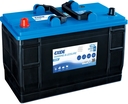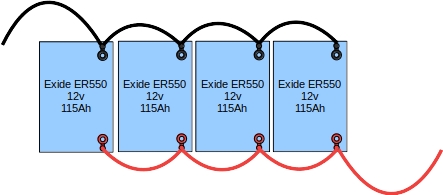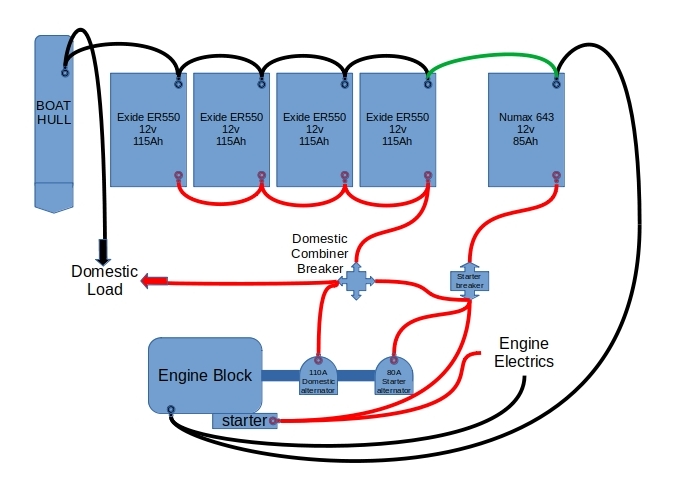a sad tale of hubris, and a warning to anyone with an Isuzu engine marinised by HMI – you need extra fuses!
This all started because I read somewhere about how to wire batteries in a parallel bank. So when I changed the batteries in May 2018 I thought I’d check all the wiring.

The Exide ER550. Four of these replaced my Domestic battery Bank. I bought them here:
https://www.alpha-batteries.co.uk/115-ah-exide-deep-cycle-leisure-battery-porta-power-115/
How to connect a Battery Bank
The correct way to connect the charge or load to a bank of batteries is DIAGONALLY, this balances losses in the connecting cables.

This is all very well, until you look at the larger picture that includes the Starter battery, both alternators, and both Engine and Domestic loads. Then the picture looks like this:

Chestnut has been working with this wiring since we had her in 2012, so the batteries had lasted 6 years. About average, but could do better, I thought. The Starter Battery is fine, it is still going strong today in 2020, so at least eight years, probably more.
However, studying the battery connections I realised there was an issue: While the domestic LOAD was fine, taken from opposite corners of the bank, how did it charge? The Domestic Alternator Positive connects to the breaker and domestic load as shown above. But where does the Domestic Alternator Negative connect? The answer: to the Engine Block, the same as the Starter Alternator. So that means the Domestic Battery bank is charging non-diagonally through the green link in the picture above. Not good, apparently, as the battery at the left-hand end never fully charges.
The missing link
And this is where the hubris comes in. I thought, well the Engine Block is bolted to the Boat Hull anyway, so if I take out the green link, the alternator will charge the battery through the engine-chassis connection into the correct corner of the bank. That error cost me £200 and a months work – if I wasn’t an engineer it would have been around £2000.
Turns out there is almost NO electrical connection between the Engine Block and the Boat Hull. The Engine is mounted on rubber blocks, maybe a vague connection through the prop shaft and hull? The only electrical connection from the engine block is the cable that connects to the negative of the starter battery, and then VIA THE GREEN LINK to the boat hull. There should be a separate cable connected between the engine block and the boat hull – there wasn’t.
Even so, I may have got away with the error, at worst the Domestic Bank would have failed to charge, but it also turned out that two critical control wires for the Domestic Alternator were connected to the wrong Battery – The Starter battery not the Domestic bank.
Ten minutes after I started the engine, with the missing link, the Domestic Alternator stopped working. This was an hour before my Cousin was due to arrive for a week’s cruising. Not to be daunted, and still unaware of the missing link issue, I removed the main charging cable between the broken Alternator and the Battery, and placed a temporary link between the starter and domestic batteries, so that the Engine Alternator would charge both batteries. And we set off.
The trip, the fire, the limp.
If I had put back the missing link at this point, it would have just cost me a new alternator, but I didn’t.
About four days into the trip I realised the Domestic Bank still wasn’t charging properly and finally put the missing link back.
The day after, about five days into the trip, we were just outside Rugeley, when the engine stopped. When I lifted the engine boards to see what was going on, the engine was on fire!
“In case of fire”, the manual says, “stop the engine, kill all the batteries, and go find the extinguishers.” As the engine was already stopped I just had to disconnect the Battery breakers – no need for the extinguisher as, although there was a lot of smoke, there was no fire. It was the wiring loom melting because some of its wires were hugely overloaded, so killing the Battery was the right thing to do.
With some odd bits of wire I managed to get the fuel pump working and trigger the starter motor. We limped home with no console, and having to lift the deck boards to stop the engine.